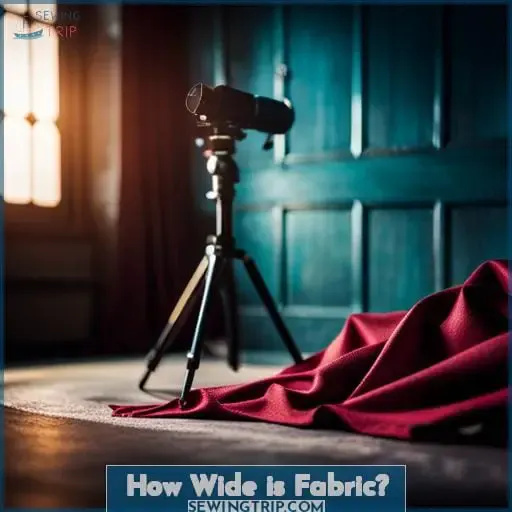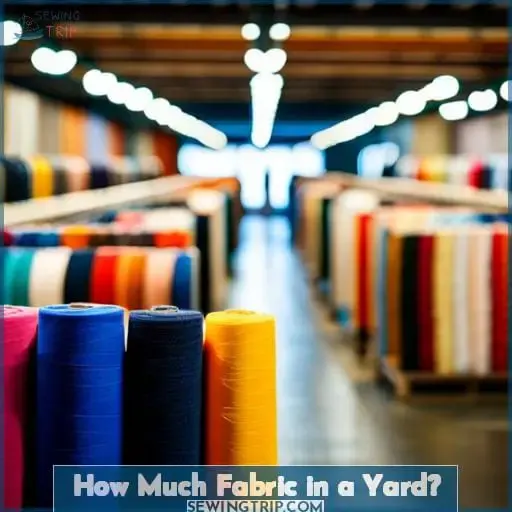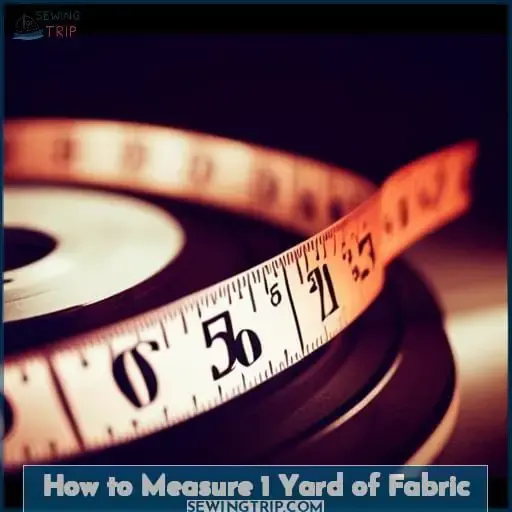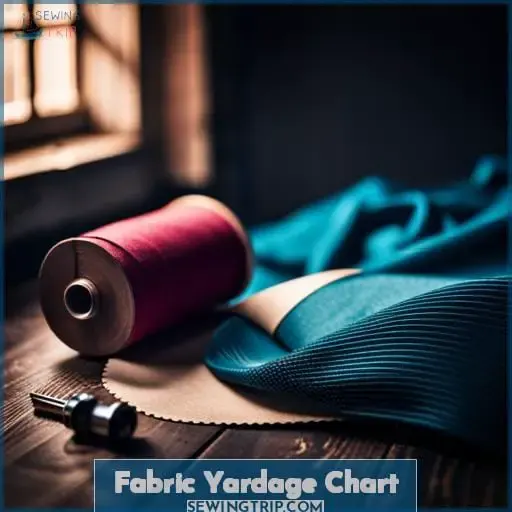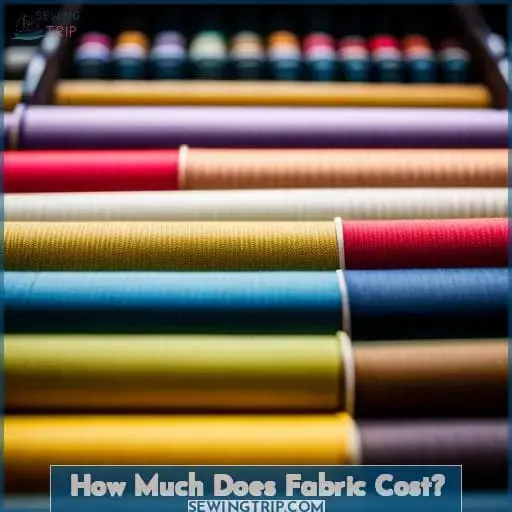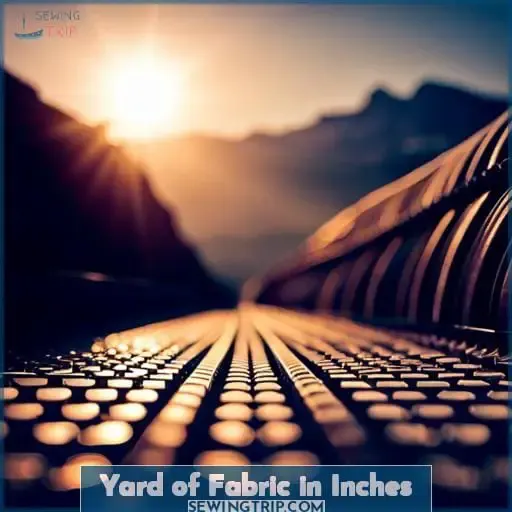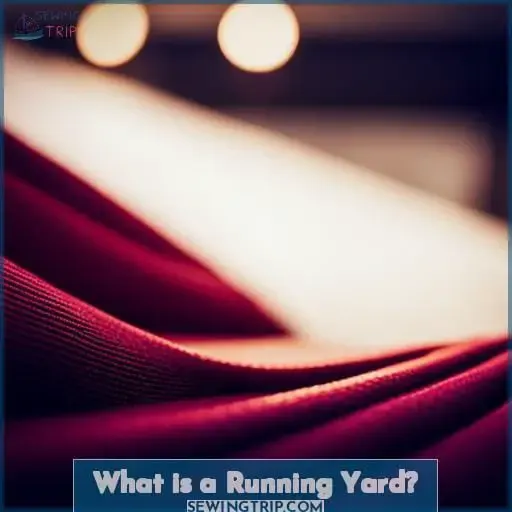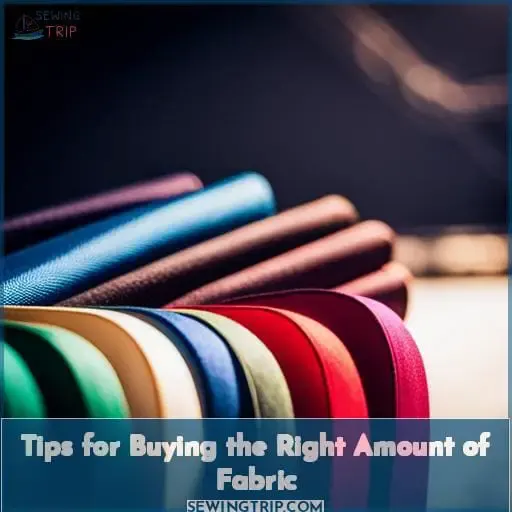This site is supported by our readers. We may earn a commission, at no cost to you, if you purchase through links.
When it comes to sewing projects, one of the first steps is figuring out how much fabric you need. Buying fabric by the yard can be confusing at times, as there are different widths and measurements available for purchase.
You may also have to convert from yards into metric units if that’s what your project calls for.
It’s important to know exactly how wide a yard is and understand the conversion chart in order to make sure you buy just enough material – not too little or too much! So let’s get started on understanding how fabric is sold and learn some tips on making sure we always buy the right amount of material needed for our next sewing project.
Table Of Contents
Key Takeaways
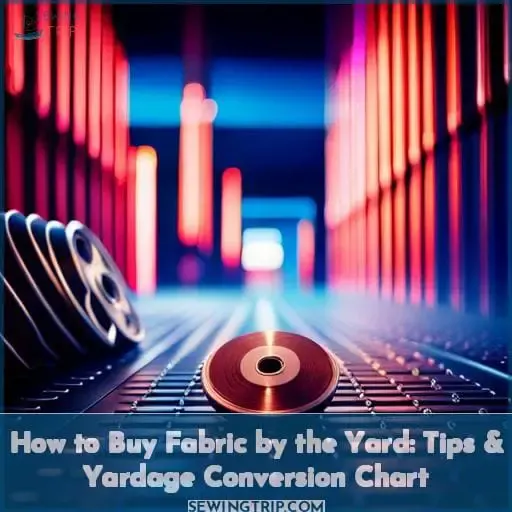
- Fabric widths can range from 12 inches to 120 inches or more, depending on the type of fabric.
- Different types of fabric have different standard widths, such as quilting cotton (44/45 to 60 inches), apparel fabric (45-60 inches), and home decor fabric (54-120 inches).
- Wider fabric widths are generally more economical as they require fewer seams and allow for efficient pattern placement.
- It is important to consider the fabric width, quality, pre-shrinking, and the use of fat quarters when purchasing fabric for a project.
How Wide is Fabric?
You may be wondering how wide fabric is typically sold, and the answer varies depending on the type of fabric.
How much do you need for your project? Fabric can come in a variety of widths, with quilting cotton usually ranging between 44/45” and 60” wide. Apparel fabrics are generally 45-60 wide, while home decor fabrics vary even wider at 54-120.
If you’re working with a non-standard size like fat quarters (18 x 21) or half yards (36x 18), then it’s important to factor in those conversions when calculating yardage requirements before pre-shrinking your fabric!
When buying yardage off bolts, it helps to understand the imperial system measurements used by most U.S.-based retailers. One full yard equals 36, two yards equal 72, and three yards equal 108. It’s also worth noting that not all yards are created equally. Not every 36″ length will measure exactly 1 yd since some fabrics have been cut slightly skew.
Fabrics like silks, heavily embroidered pieces, and laces tend toward narrower widths, so take this into account as well when determining the amount needed per pattern piece if applicable.
Wider cloth is often more economical since fewer seams must be sewn together. But regardless of size, always buy an extra 10%-15% over what you anticipate needing just in case there are any unforeseen missteps during pattern cutting time! The cost per unit area increases significantly on smaller amounts too, so plan ahead accordingly if budgeting plays an important role here too.
No matter where purchased from, always ensure the exact number required is obtained the first time around. Otherwise, any budgetary savings could evaporate quickly due to post-purchase corrections incurring additional shipping costs, etcetera should these arise unexpectedly later down the line.
How Much Fabric in a Yard?
Understanding fabric measurements and yardage conversion is crucial when determining the amount of fabric needed for any project. Different fabrics come in varying widths, ranging from 12 inches to 120 inches or more.
Therefore, it is important to consider the size of a yard as well as its cost per unit area before making a purchase. Additionally, it is advisable to buy an extra 10-15% of fabric to account for any unforeseen errors that may occur during the cutting process.
Fabric Measurements
Understanding the measurements of fabric is essential for accurately purchasing enough yardage to complete your project. A helpful guide when determining how much fabric you need is a yardage chart, which can be used to calculate approximate amounts based on the size and type of sewing project.
It’s also important to factor in fat quarters, pre-shrinking fabrics before cutting them out, selvage trimming, and other considerations when doing calculations.
When looking at the size of a yard of fabric, it’s important to take into account its width. Fabric comes in widths ranging from 28 inches up to 60 or more inches wide depending on the type. This will affect how much you need for your project. Wider cloth tends to be more economical as fewer seams must be cut together.
Additionally, use a straight edge ruler along with a reliable tape measure or even better yet, get yourself an online ‘Fabric Measurements Calculator’ that makes quick work out of calculating exact amounts needed per sewing projects quickly & accurately.
With these tools and tips by your side, creating garments or home decor pieces has never been easier!
Yardage Conversion
Knowing the width of fabric is key when determining how much you need for your project, so using a yardage conversion chart can help ensure you get exactly what’s needed.
To accurately buy fabric for projects, it’s important to measure in inches and then convert into yards or meters if working with metric measurements. Fabric widths range from 28 inches up to 60 or more depending on the type used. Wider cloth tends to be cheaper as there are fewer seams that must be cut together.
Pre-shrinking fabrics before cutting them out also makes sure exact yardage is bought since shrinkage varies by fiber content and weave structure of each material being used.
The length of fabric will always remain 36” regardless of its width, but knowing this number helps determine how many pieces fit within a given space when pattern planning too.
Buying just enough material means not wasting time and money while avoiding having piles of leftover scraps either.
How is Fabric Sold?

When it comes to buying fabric, you need to consider the width of the material and how much yardage is required before making a purchase. It can be helpful to familiarize yourself with different types of fabrics and their typical widths in order to determine what type and amount are needed for your project.
If possible, take note of any related tutorials or ask a sales attendant at your local fabric store for advice on determining how much material is necessary. Additionally, pre-shrinking the fabric before cutting out pattern pieces may help ensure that it fits properly after sewing together.
Keep in mind that not all yards are created equal. Wider materials require less yardage than narrow ones because more pattern pieces can fit within its dimensions without having extra seams sewn into them.
Thus, taking this knowledge into consideration beforehand will allow one’s wallet some breathing room afterwards while also helping avoid unnecessary wastefulness which could come about should someone incorrectly estimate their needs initially!
Conversely, however, if shopping online, then make sure to double-check measurements listed by sellers against those found elsewhere so there won’t be any surprises upon receiving orders – especially since prices vary widely between merchants offering similar items sometimes even though they claim theirs offers superior quality compared against others who don’t offer comparable value propositions either due solely based off name recognition alone instead!
Taking these tips into account prior to beginning the purchasing process might just save time (as well as money!) down the line when starting craft projects utilizing new supplies acquired from marketplaces near and far alike, no matter where one lives – always remember to measure twice, cut once!
How to Measure 1 Yard of Fabric
Now that you know how fabric is sold, it’s time to learn how to measure a yard of fabric. Measuring 1 yard of material accurately can be difficult due to the variety and widths of fabrics available.
It’s important to take into account the selvage trimming, pre-shrinking, and cutting mistakes when determining the right quantity of fabric for your project.
The best way to measure 1 yard is by comparing different cuts against each other or using an online tutorial that shows what one wide x 1-yard looks like on various types and widths of materials. This includes quilting cotton (44/45 inches), apparel fabrics (60 inches), or home decor fabrics (60+ inches).
By taking these measurements into consideration beforehand, you can ensure that you get enough material for your project without having too much leftover at the end!
To make sure that you are getting exactly 36 per single cut across all types/widths, use a ruler tape measure. Also, note down any skews before marking where each piece should begin and end so there won’t be any surprises once sewing together begins.
Lastly, don’t forget to consider conversion factors between yards and meters before making purchases in overseas marketplaces. Prices can vary widely depending on location, even though both units represent the same physical lengths.
Fabric Yardage Chart
Make sure you get the exact amount of fabric you need for your project by referencing a Fabric Yardage Chart. Knowing how to accurately measure 1 yard of fabric is critical when determining how much material will be needed for a given project, as well as what type and width are best suited.
The chart allows you to easily compare different cuts against each other or use an online tutorial that shows what one wide x 1-yard looks like on various types/widths of materials such as quilting cotton (44/45 inches), apparel fabrics (60 inches), or home decor fabrics (60+ inches).
The handy table below provides an overview of common measurements used in fabric yards conversions, selvage trimming, pre-shrinking considerations, bolt widths fractions relative to the total length per square yard:
| Measurement | Equivalent Length | Total Yards Per Square Yard |
|---|---|---|
| Yard | 36 Inches | 9 |
| Half Yard | 18 Inches | 4½ |
| Quarter Yard | 9 Inches | 2¼ |
| Fat Quarter | 18×22 inch rectangle cut diagonally from half yard after selvage removed ~ 2¾ yards | Selvages Cuts & Pre Shrink Considerations |
| 1 off sides = 8†total across all lengths = 3⅓ yds | Bolt Widths | 45, 60 & 72: 6 full strips=3 yds; 5 full strips=2½ yds; 4 full strip equaling 2yds |
| Fractions Of The Yd | ½ + ¼ + â…› = 7â„8th’sd equal.875y ; â…œ + ¼ plus â…› equals 11â„8ths which would both equal 1.125yards | Fabric Cost Estimator – Based On Average Price Per Linear Foot |
44-$4-$6 / 55-$5-$7 / 108 – $10-$15 / 120 – $12 -$17 Price Varies By Store And Quality
By taking these measurements into account beforehand and using this helpful reference guide coupled with ruler tape measures will ensure accuracy while cutting multiple layers simultaneously during pattern layout arrangements!
Additionally, don’t forget conversion factors between yards and meters before making purchases overseas marketplaces since prices can vary widely depending on location even though both units represent the same physical lengths too!
How Much Does Fabric Cost?
Knowing the width of the fabric and how it affects your project’s needs can help you get an idea of how much it’ll cost.
- Check the quality – not all fabrics are created equal, so be sure to read up on yarns, weaves, finishes, etc.
- Consider different fabric widths – from 12 inches to 120 inches, there is plenty of variety in terms of available dimensions.
- Pre-shrink your material if necessary – this will ensure that no shrinkage occurs later on when washing or pressing.
- Take fat quarters into account – these 18×22 inch rectangles cut diagonally from half-yard lengths after selvages removed can add up quickly!
When looking at pricing for yards/square yards/meters, keep in mind hidden costs such as pre-shrinking and selvedge trimming, as well as bolt fractions relative to the total length per square yard, which also affect the overall price.
One important factor is understanding actual size measurements since many online retailers may list sizes differently than standard measurements like 36 inches = 1 yard (or 0.
Yard of Fabric in Inches
You can easily calculate the size of a yard of fabric in inches by remembering that it is equal to 36 inches or 3 feet. Knowing this measurement will help you when planning projects and calculating how much material you need for them.
When buying fabric, it’s important to take into account the widths available as well as any pre-shrinking or selvage trimming required before cutting your pattern pieces. The most common widths are 44/45 inches and 60 inches, but they can range from 12–120+ inches depending on the type (e.
Wider fabrics are usually more economical since efficient placement patterns with minimal waste remaining afterward are possible. However, some types like silks may be narrower due to heavily embroidered designs, etc.
It’s recommended to buy at least 10% extra material just in case there are mistakes while working with patterns – particularly if needing a straight cut along the edge without distortion occurring too! Additionally, one square yard covers an area almost 4 times larger than 1 yard lengthwise, so keep that in mind when measuring out materials needed for specific projects too!
With all this information taken into consideration, plus helpful resources found online about exact amounts per particular type & desired outcome goals, whether domestically or overseas markets alike – now you have everything necessary for accurate calculations based upon yards/square yards/meters.
What is a Running Yard?
A running yard of fabric is simply a continuous length with no breaks or seams, allowing you to achieve the exact measurements needed for your project. It can be used to measure a variety of fabrics, including quilting cotton, apparel fabric, and home decor fabric.
Wider fabrics are often more economical since they allow for efficient pattern placement and less waste. However, silks may be narrower due to heavily embroidered designs or laces that require special care when cutting.
It’s recommended that at least 10% extra material should always be purchased just in case there are any mistakes while working with patterns. This is particularly important if you need a straight cut along the edge without distortion occurring.
Also, it’s important to know how much space one square yard covers. It is almost 4 times larger than 1 yard lengthwise. So, take this into account when measuring out materials for different projects as well.
Lastly, remember that buying by ‘the running yard’ means an uninterrupted piece, ensuring DIY hat makers get exactly what they need without worrying about misjudging sizes and wasting valuable time and money on wrong amount orders placed online or elsewhere, either domestically or in overseas markets alike.
Tips for Buying the Right Amount of Fabric
When purchasing fabric for a project, it’s important to consider the width of the material and ensure you get the exact amount needed – but how do you make sure that happens? To buy fabric correctly, there are certain tips and tricks to keep in mind.
Firstly, measure your desired length using either an imperial tape or yardstick – one yard is 36 inches or 3 feet long.
Secondly, take into account any half-yard pieces by adding up all possible lengths. If two yards are requested but only 1 ½ yards will fit on a single piece of material, then four fat quarters will need to be purchased instead.
Thirdly, always pre-shrink fabrics before cutting as this can help prevent distortions when sewing later on – especially with natural fibers like cotton!
Lastly, use a fabric conversion chart if working between metric/imperial systems: one meter = 39¼” (or 3ft 3 ¼).
To make buying the right amount of fabric easier still, try these helpful hints:
- Always have extra in case mistakes occur while pattern cutting.
- If wider materials are used, they allow for more economical placing of pattern pieces.
- Consider selvages which may add additional length when calculating yardage needed.
- Check quality carefully as some fabrics come narrower than others, e.g., silks & laces.
- Don’t forget about fat quarters – useful 18×22 inch rectangles cut diagonally from half-yards after selvages removed.
By following these simple steps, consumers can rest assured they’ll have enough material without overspending their budget unnecessarily! Remember too that small leftover scraps from projects can become treasures down the line, so don’t be afraid to save them where possible while also looking out for special deals online or at local stores which could save money too! With proper research and knowledge, anyone should now feel confident picking just what’s required each time, no matter whether it’s imperial measurements OR the US system being employed here.
Frequently Asked Questions (FAQs)
What types of fabric are available?
Discover a variety of fabrics, including quilting cotton, apparel fabric, home decor fabric, and more. Explore the different widths available, ranging from 12 inches to 120 inches. Understand that each type of fabric has its own unique width and cost, which can vary greatly depending on quality and source.
What is the difference between a yard and a running yard?
A yard of fabric is a fixed measurement of 36 inches. A running yard, however, is sold as one continuous length regardless of its width and can vary in size. It’s important to consider the type and width when purchasing fabric by the running yard to ensure you get enough for your project.
Is pre-shrinking fabric necessary?
Pre-shrinking fabric is essential for ensuring a successful project. The process of pre-shrinking helps prevent the material from shrinking further during the sewing process, resulting in a poor fit and wasted fabric.
How do I know how wide a fabric is?
You can determine the width of fabric by checking its label or looking online. Consider the type, weight, and pattern when making your selection to ensure you get the desired look and feel for your project.
What should I do with leftover fabric?
Discover ways to get creative with leftover fabric. Use scraps for quilting, patchwork projects, or make a coordinating pillowcase out of them. Make doll clothes or accessories like hair bows and bags. Create small decorations such as bunting banners, tassels, wall hangings, and garlands.
Conclusion
You’ve come to the end of your journey of understanding fabric measurements and how it is sold. Now you know that fabric is sold in widths ranging from 28 inches to 60 inches or more, and is priced per yard or half yard.
You also understand the importance of pre-shrinking the fabric and cutting off the selvage before starting a project. It’s important to buy a little extra fabric in case of pattern cutting mistakes, and fabric widths can affect the amount of fabric needed.
Now you can confidently purchase the right amount of fabric for any project! With this newfound knowledge, you’ll be an unstoppable force in the crafting world.

